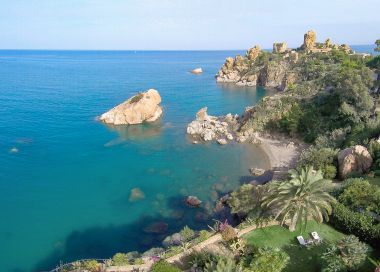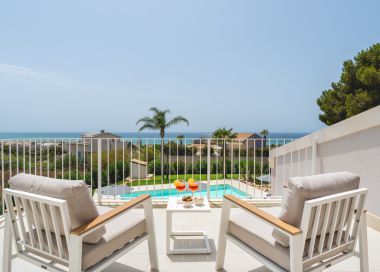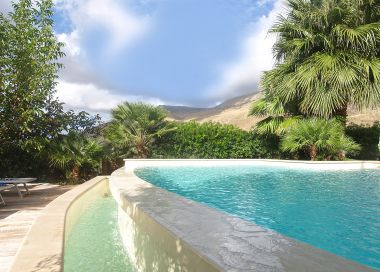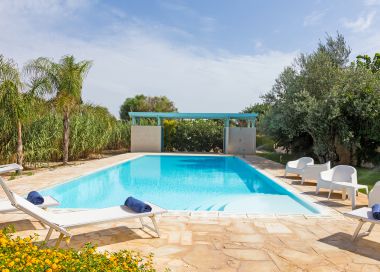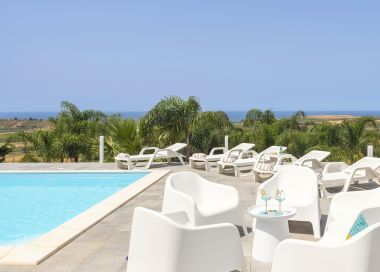Sicilian cuisine
The pleasures of the palate: a journey through the island's culinary culture which has existed for more than a thousand years
Sicily is the cradle of flavours and aromas, thanks to nature and to the capable hands of the island's inhabitants who have transformed the enormous range of local ingredients at their disposal into veritable delicacies for the palate. The origins of Sicilian cuisine are remote to say the least - Sicily's dessert par excellence, the Cassata Siciliana, for example, dates back around 1,200 years! No less the history of other typical sweets which take their shape or name from the regions in which they are produced. The most famous and noteworthy, other than the Cassata, are Cannoli, Trionfo della Gola, Zuccata, "Cuccia", "Minni" di Vergine, "Sfinci" di San Giuseppe, Cotagnata, Buccellato and the Pignolata di Messina. All are prepared with typical ingredients which include ricotta cheese, sugar, almond paste, marzipan, candied fruit, orange, lemon and citron peels, chocolate and dried fruit. There will be no shortage of opportunities for you to sample these delights in the numerous pastry and confectionery shops located throughout the island. To the list of specialities can be added Brioches with ice cream and cream, a true regional speciality which often replaces a meal for many Sicilians, granitas, a drink made from crushed ice and avaialble in various different flavours the most famous of which are mulberry, lemon and coffee, and Water Melon Jelly. The most famous hors d'oeuvres include aubergine Caponata, made from a selection of vegetables and olives in a sweet-and-sour sauce, seafood salad made with octopus, squid and boiled prawns, fritella made with beans, peas and artichokes, and a range of fried specialities which include panelle (chick pea fritters), crocche di patate (potato crocquettes), carciofi (fried artichokes) and broccoli (fried broccoli) which are usually eaten at local road-side stalls along with pane "ca meusa", breadrolls stuffed with sauted beef spleen. Other typical street snacks include la "frittola" made with fried offal, il "musso" made with beef cartilage and "Stigghiola" made with sheep's entrails. There are numerous typical dishes served at table, many of which are popular in origin and as a result were traditionally prepared with cheap and basic ingredients. First and foremost are the starters and above all those which contain fish such as pasta con le sarde e finocchietto (pasta with sardines and wild fennel), pasta con i broccoli "arriminati" (pasta with broccoli), pasta con la bottarga (pasta with salted tuna fish eggs), pasta alla "Norma" with aubergines and pecorino cheese, pasta alla "glassa" with potatoes, cous cous with fish, a dish which originated in Africa but is now typical of the area around Trapani, pasta con "l'anciova" (pasta with anchovies) and pasta "chi fasola" with beans. Over the centuries a range of other pasta dishes have been added, many of which include fish, such as pasta con i ricci (pasta with sea urchins) and with i frutti di mare (mixed seafood). Worthy of special mention is pasta al forno, a real Sicilian delicacy, which is cooked in a dish in the oven and is made with anelletti (spaghetti rings), tomato sauce, fried aubergines and minced beef. Main courses worthy of mention include "brociolone" made with minced beef and egg, "tunnina ammuttunata" (a slice of tuna fish with tomato), "stoccu" alla messinese made with cod, polpi "murati" (octopus), fritture di pesce (fried fish) and carni e salsicce alla brace (grilled meats and sausages). A rich selection of cheeses made with sheep and cow's milk is available such as pecorino, "maiorchino", "Tuma", "Primosale", "Canestrato", "Caciocavallo", "Vastedda" from Belice, "Priminitino" and a range of provola cheeses which vary in name and taste according to the region where they are produced. Bread is an absolute necessity on the Sicilian dining table and is cooked fresh on a daily basis (even on Sundays) from 4 o'clock in the morning until 9 o'clock at night. The most popular type of bread is pane di "casa" which is cooked in a wood oven and is a speciality of Monreale and Piana degli Albanesi. Another special bread is the pane nero di Castelvetrano, winner of an award from the Slow Food movement. If you happen to come across a car or small van by the side of the road on a Sunday selling bread we recommend that you stop and buy some! Other delicacies include salamis such as the famous salamis prepared at San'Angelo di Brolo with meat from the black pigs of the Nebrodi mountains.
In the various bars to be found throughout the island, even in the smallest villages, other than a stop for the "obligatory" espresso coffee you will have an opportunity to sample one of the many savoury delights on offer from behind the counter. You really must try some of the most famous of these specialities such as arancina (or arancino) fritta with rice and cheese or meat, calzoni fritti (fried) or al forno (baked) with prosciuto ham and cheese, "ravazzata" fritta with meat, spiedino fritto with meat, "rizzuola" fritta with meat and sfoglia con carne also with meat. Traditional sweet delicacies worthy of mention include ciambella fritta (a circular fried doughnut covered in sugar), "graffe" fritte with sugar and sfoglie and panzerotti with sweet ricotta cheese in addition to a dizzying array of biscotti (biscuits) and pasticcini (small cakes).
The list of Sicilian products recognized by the Slow Food Movement includes:
asino di Ragusa, cappero di Salina (capers from Salina), lenticchia di Ustica (lentils from Ustica), fagiolo “a badda” di Polizzi Generosa (beans from Polizzi Generosa), fava di Leonforte (beans from Leonforte), formaggio maiorchino (maiorchino cheese), mandarino di Ciaculli (mandarins from Ciaculli), mandorle di Noto (almonds from Noto), manna delle Madonie (manna from the Madonie), Pane nero di Castelvetrano (black bread from Castelvetrano), pesche di Leonforte (peaches from Leonforte), pistacchio di Bronte (pistachios from Bronte), provola dei Nebrodi e delle Madonie (provola cheese from the Madonie and Nebrodi mountains), susine di Monreale (plums from Monreale), formaggio Vastedda del Belice (Vastedda cheese from Belice), pane di Lentini (bread from Lentini), oliva minuta (the minuta olive), melone “porceddu” di Alcamo ("porceddu" melons from Alcamo), alice “masculina” ("masculina" anchovies), cipolla di Giarratana (the Gairratana onion), capra Girgentana (the Girgentana goat), aglio rosso di Nubìa (red garlic from Nubia), ape nera sicula (sicula black bees), “cuddridedda” di Delia (rolls of pasta from Delia), limone interdonato della costa ionica (interdonato lemons from the Ionic coast), and cioccolato di Modica (chocolate from Modica).
Sicilian wines have become extremely fashionable in recent years and their success is the result of a decision to concentrate on the production of quality wines rather than maximising quantity and producing wines suitable for sale only in bulk. Today there are numerous wineries producing red wines and sweet and dry white wines that are recognised around the world and we have dedicated a separate chapter to wine under the heading Wine Routes
In the various bars to be found throughout the island, even in the smallest villages, other than a stop for the "obligatory" espresso coffee you will have an opportunity to sample one of the many savoury delights on offer from behind the counter. You really must try some of the most famous of these specialities such as arancina (or arancino) fritta with rice and cheese or meat, calzoni fritti (fried) or al forno (baked) with prosciuto ham and cheese, "ravazzata" fritta with meat, spiedino fritto with meat, "rizzuola" fritta with meat and sfoglia con carne also with meat. Traditional sweet delicacies worthy of mention include ciambella fritta (a circular fried doughnut covered in sugar), "graffe" fritte with sugar and sfoglie and panzerotti with sweet ricotta cheese in addition to a dizzying array of biscotti (biscuits) and pasticcini (small cakes).
The list of Sicilian products recognized by the Slow Food Movement includes:
asino di Ragusa, cappero di Salina (capers from Salina), lenticchia di Ustica (lentils from Ustica), fagiolo “a badda” di Polizzi Generosa (beans from Polizzi Generosa), fava di Leonforte (beans from Leonforte), formaggio maiorchino (maiorchino cheese), mandarino di Ciaculli (mandarins from Ciaculli), mandorle di Noto (almonds from Noto), manna delle Madonie (manna from the Madonie), Pane nero di Castelvetrano (black bread from Castelvetrano), pesche di Leonforte (peaches from Leonforte), pistacchio di Bronte (pistachios from Bronte), provola dei Nebrodi e delle Madonie (provola cheese from the Madonie and Nebrodi mountains), susine di Monreale (plums from Monreale), formaggio Vastedda del Belice (Vastedda cheese from Belice), pane di Lentini (bread from Lentini), oliva minuta (the minuta olive), melone “porceddu” di Alcamo ("porceddu" melons from Alcamo), alice “masculina” ("masculina" anchovies), cipolla di Giarratana (the Gairratana onion), capra Girgentana (the Girgentana goat), aglio rosso di Nubìa (red garlic from Nubia), ape nera sicula (sicula black bees), “cuddridedda” di Delia (rolls of pasta from Delia), limone interdonato della costa ionica (interdonato lemons from the Ionic coast), and cioccolato di Modica (chocolate from Modica).
Sicilian wines have become extremely fashionable in recent years and their success is the result of a decision to concentrate on the production of quality wines rather than maximising quantity and producing wines suitable for sale only in bulk. Today there are numerous wineries producing red wines and sweet and dry white wines that are recognised around the world and we have dedicated a separate chapter to wine under the heading Wine Routes

























